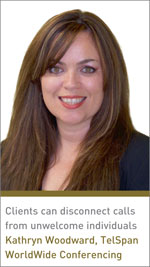Adam Piore investigates different approaches to the all-important earnings call and gets tips for stage-managing the event
Few events offer as great an opportunity for a catastrophic gaffe as company earnings calls.
With analysts, investors and the media often scrutinizing every word for meaning, any stray, unplanned comment can send share prices tanking.
Executives who stumble, sound overwhelmed or panic due to technical glitches can also spook investors.
‘Typically we’re dealing with the health and finances of the company,’ says Marc Gutman, founder and chief meeting officer of Lighthouse Conferencing.
‘If these are not presented well, it reflects very poorly on the firm. You could absolutely lose value on an unsuccessful call.’
But never fear: in recent years, IR professionals and independent companies have unveiled a whole host of techniques and products to help stage-manage the event.
All of them are based on the same underlying idea: prepare, prepare, prepare.
For the record
A growing number of companies elect to prerecord initial remarks for the earnings call. Gutman generally has the chief financial officers or chief executives of clients who use his company’s prerecording services come in three or four days ahead of the call to record a full presentation.
Once a successful take has been recorded, audio technicians go to work, editing out stammering and any ‘ums’ and ‘aahs’.
Despite this service, notes Gutman, ‘some executives are very polished and are one-shot-type people who say, Look, I got it, and elect to go live.’
Even those who prerecord calls, however, usually follow them with a question-and-answer period, and preparing for that is just as important. Rob Berick, a senior managing consultant at public relations and IR firm Dix & Eaton, advises his clients to plan the prepared remarks and the questions and answers in tandem.
Rob Berick, a senior managing consultant at public relations and IR firm Dix & Eaton, advises his clients to plan the prepared remarks and the questions and answers in tandem.
He encourages them to start by listing the issues and concerns likely to be at the top of the agenda for investors.
‘The earnings call shouldn’t be just a regurgitation of the earnings release,’ Berick asserts. ‘There should be some critical thinking about what the areas of confusion are for shareholders, what their concerns are, and where they are most likely to want greater transparency.’
Once those questions have been answered, adds Berick, the process simply becomes an exercise in organization and practice.
‘The more you put into those prepared remarks, the more you facilitate a healthier conversation during the Q&A section, because you are not asking the investors to ask for information you would otherwise give them anyway,’ he explains.
‘I always maintain that if you debate whether to put something in the prepared remarks for more than 15 seconds, it’s obviously something you need to include.’
Practice is key to ironing out the correct sequence of the prepared remarks and identifying potential ‘traps’ that might emerge during the Q&A.
‘There are going to be certain items you will have covered in prepared remarks that are going to get follow-up questions, and they will be flashpoints,’ Berick continues.
‘You can either practice and learn the way you are going to manage that discussion so that it becomes a good use of everyone’s time, or you can leave it to chance and either end up getting burned – or leaving the investor feeling that he or she got burned.’
Prepared comments, Berick adds, can be used to set the table for responses to hot-button questions, providing background information that can be referred to during the Q&A to make a point.
Live and kicking
Once the session is live, various tools exist to help manage the call. TelSpan WorldWide Conferencing is one of a number of companies that offer their clients dashboards to manage conference calls.  Kathryn Woodward, manager of client services at TelSpan, says her company provides a visual representation of the conference call that shows what phone numbers are on the call and who is queued up to ask a question.
Kathryn Woodward, manager of client services at TelSpan, says her company provides a visual representation of the conference call that shows what phone numbers are on the call and who is queued up to ask a question.
If the call is secure, the company can assign PIN numbers to those who call in, which can be used to identify each caller by name.
In addition, ‘if clients have unruly or unwelcome individuals who dial in, they can always mute the line or even disconnect the call from the dashboard,’ she adds.
Berick advises his clients to come up with a ‘kill phrase’ that serves as code to an operator to put a caller into listener mode.
‘If you have someone who becomes hostile on the phone, how do you preserve the discussion for all investors and not allow one particular participant to hijack the call for his or her own agenda?’ he asks.
‘I think I have used the kill phrase only three times over the course of 20 years, but it’s important to have it to make sure you maintain control.’
When Berick was on the corporate side, he instructed his chief executives to use the phrase: ‘Well, we are not going to spend a lot of time on that issue today’ to flag the operator, before launching into agreed-upon messaging while the operator muted the caller’s ability to follow up.
Lighthouse – and many other conferencing companies – offers a back-door audio line to an operator, allowing an IR executive to deliver instructions verbally.
These firms also offer an online dashboard that lists individuals who have queued up to ask questions and have had their names inputted into the system by the operator. The technology allows the user to mute or dismiss individuals and move callers to the front or the back of the line.
‘You can drag and drop those individuals you want the operator to call on to the top of the queue, and you can dismiss or drag and drop to the bottom those people who you don’t know or don’t want to ask questions,’ Gutman says. ‘I think this is extremely powerful for controlling messages.’
To make sure those participating are prepared, Gutman recommends a dry run of the call using the technology well before the actual event.
Screen time
Sam Levenson, former senior vice president for investor relations at Sony Corporation of America, used similar tools to help the company’s Japanese chief financial officer handle the language barriers during conference calls.
Levenson projected the names of conference call participants onto one large screen and the lineup of those who were queued up to ask questions on another, and installed a third screen to track the questions being asked.
‘Sometimes analysts ask three-part questions, and by the time you get to the third part, you have forgotten the question,’ he says. ‘It’s particularly difficult when English is not your first language, so the screens just made things a lot simpler.’
At the end of any conference call, Berick encourages management to deliver a brief closing statement of between 30 and 90 seconds in length.
Doing so will likely still leave investors about 40 minutes to ask questions, he notes, and the remaining questions at the end of the session will probably be ‘well off into the weeds’, such as checking tax assumptions or clarifying obscure numbers.
‘The closing statement is an opportunity to reset the table and make sure you leave investors with the last two or three things you want them to remember,’ Berick says.
‘They’ve just been on your call for 60 minutes, plus however many other calls have happened over the two-week period. I think you owe it to the audience to recap and crystallize the three or four key takeaways.’










